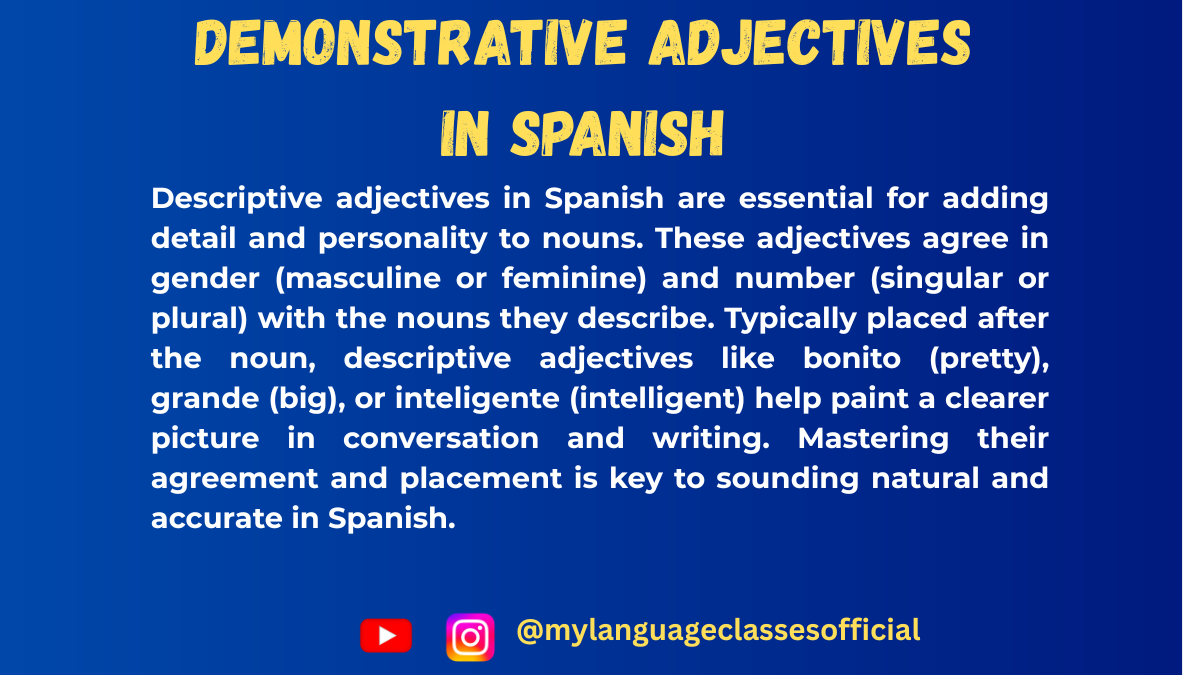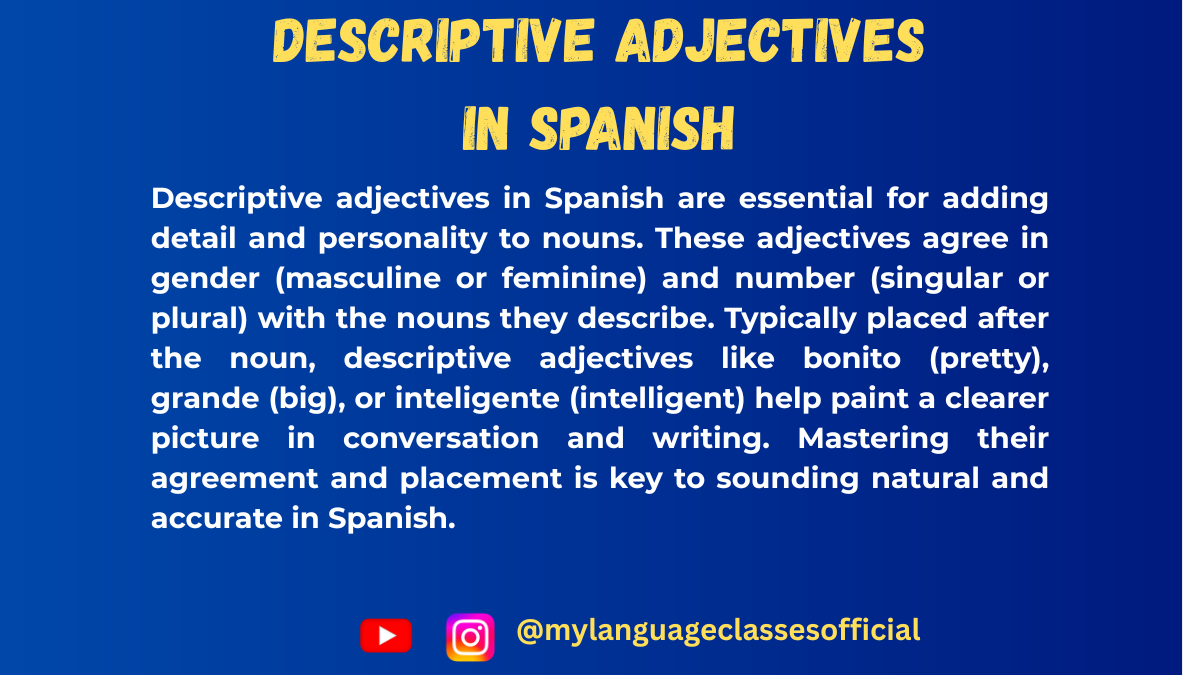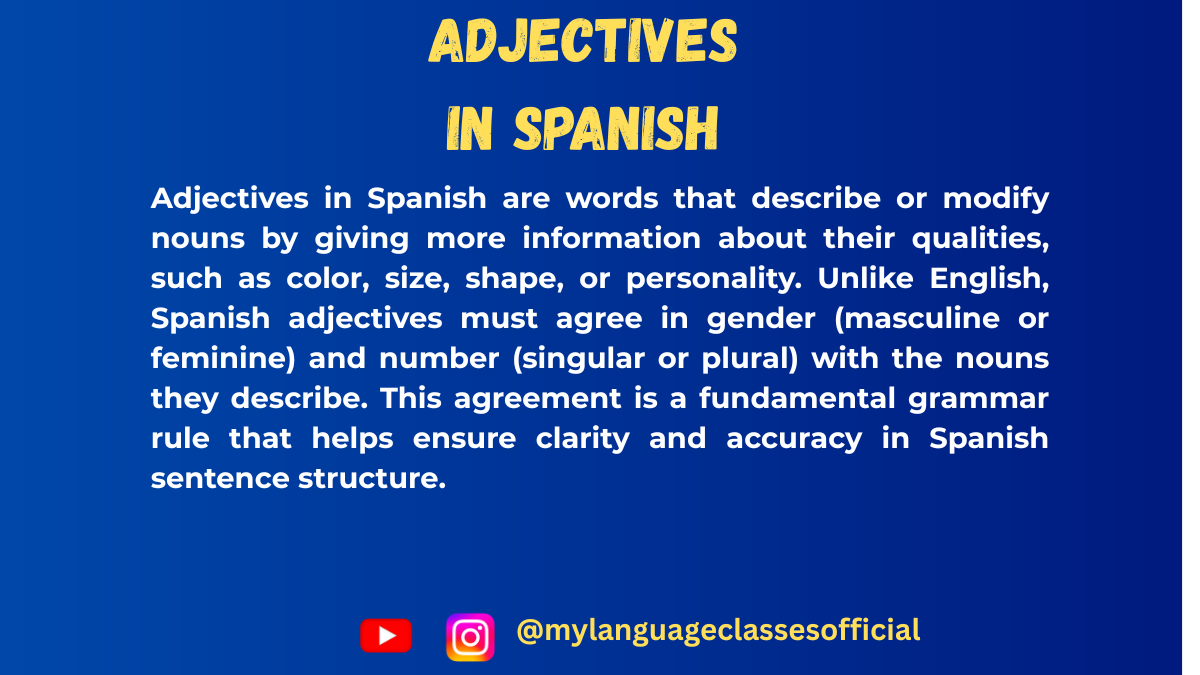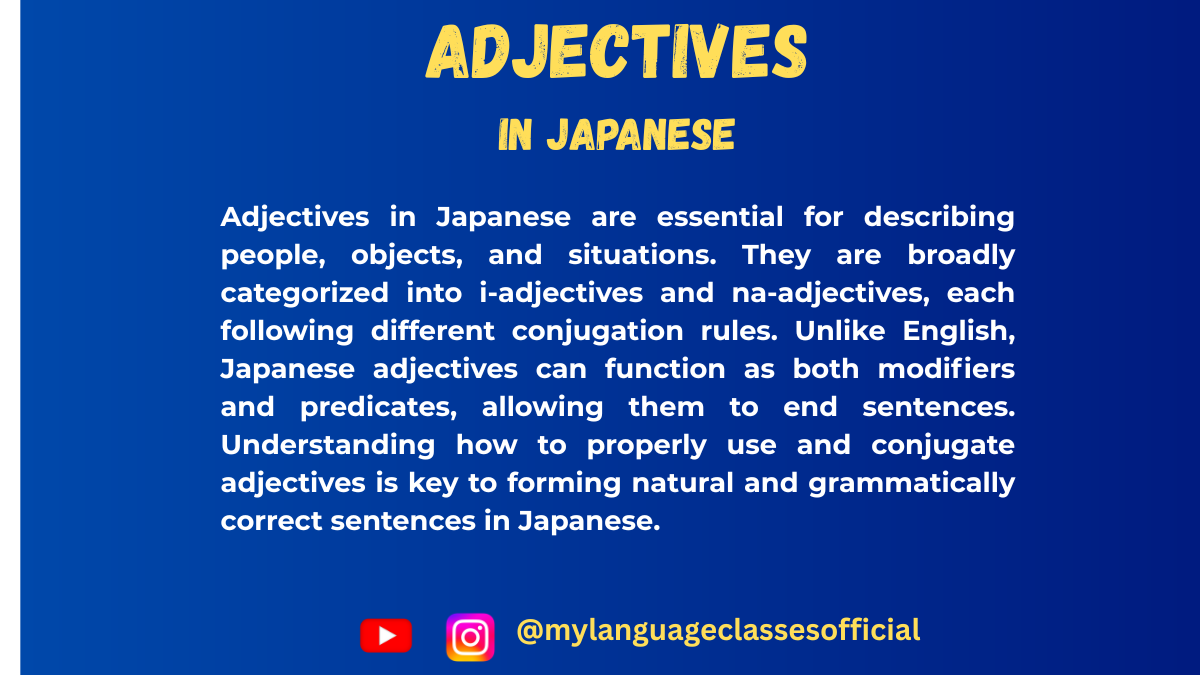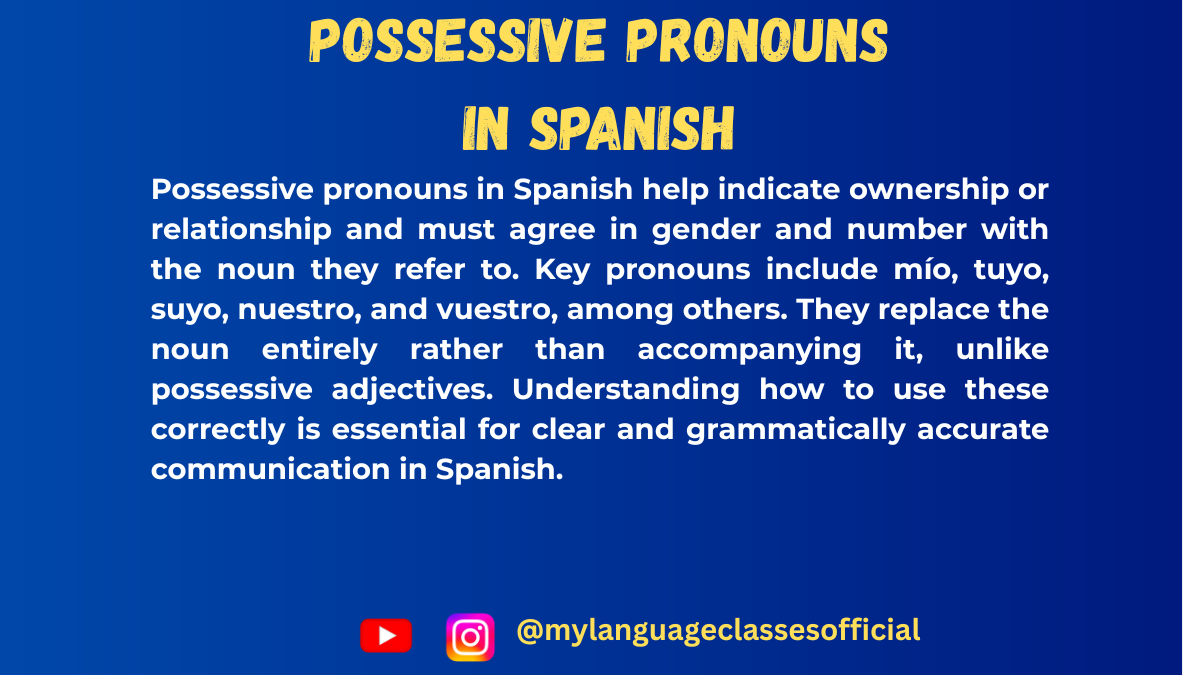Your cart is currently empty!
Tag: my language classes
-
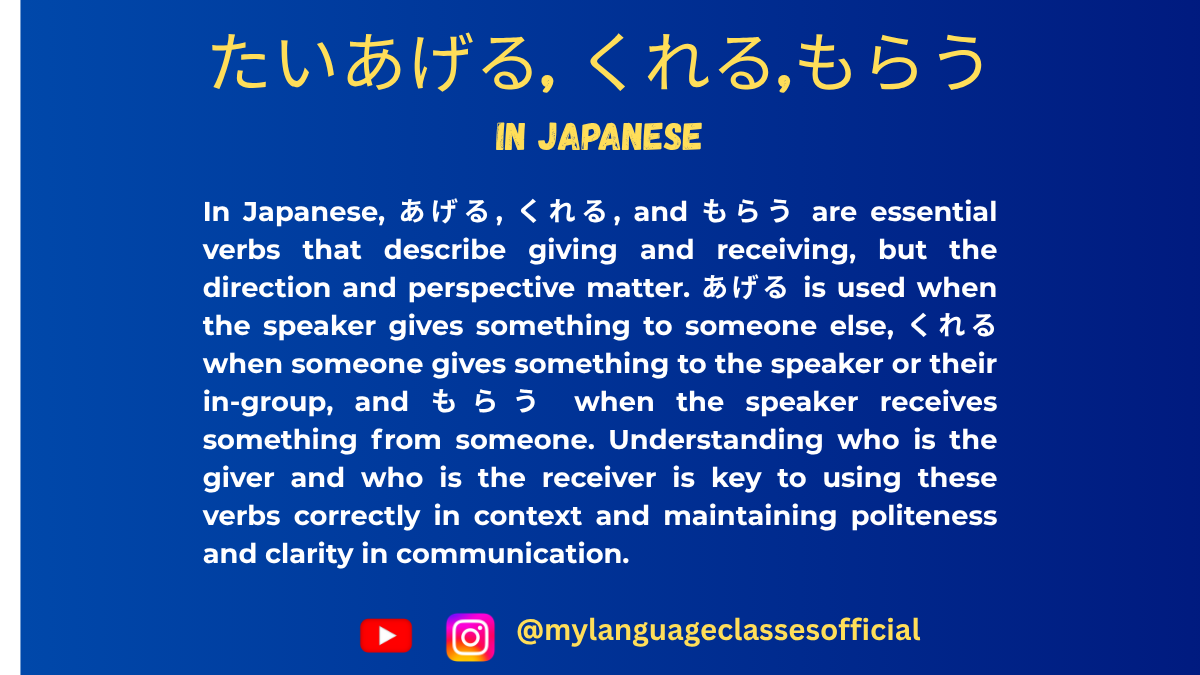
Mastering あげる, くれる, もらう in Japanese
Mastering あげる, くれる, and もらう in Japanese
In Japanese, verbs of giving and receiving are key to navigating interpersonal relationships and expressing social dynamics. These verbs—あげる (ageru), くれる (kureru), and もらう (morau)—carry not only their literal meanings but also nuances reflecting social positioning and perspective. Understanding these verbs will elevate your Japanese communication skills and cultural comprehension. Let’s break them down with examples to guide your learning.
あげる (ageru): To Give (When You or Someone Gives to Others)
あげる emphasizes that the giver (the subject of the sentence) is offering something to someone else. It is often used when the recipient is considered equal to or higher in social status.
Example 1: Giving a Book to Your Mother
母に本をあげる
(Haha ni hon o ageru)
“I give a book to my mother.”Here, the giver (you) is offering the book to your mother. The に particle marks the recipient of the action, in this case, “mother” (母).
Example 2: Giving Chocolates to a Friend
友達にチョコレートをあげる
(Tomodachi ni chokorēto o ageru)
“I give chocolates to my friend.”あげる frames the action from the perspective of the giver, showing that the chocolates move from you to your friend.
くれる (kureru): To Give (When Someone Gives to You or Your Group)
くれる is used when someone gives something to you, your family, or your inner circle. It reflects the act of giving from the recipient’s (your) perspective.
Example 1: Receiving a Present from a Friend
友達がプレゼントをくれる
(Tomodachi ga purezento o kureru)
“My friend gives me a present.”Here, the subject is “friend” (友達), who is giving the present (プレゼント) to you. Notice how くれる focuses on the speaker’s perspective, framing the act of giving as it relates to you.
Example 2: Your Sister Gives You a Pen
妹がペンをくれる
(Imōto ga pen o kureru)
“My younger sister gives me a pen.”The action is centered on what you (the speaker) receive, with the subject being the giver (your sister).
もらう (morau): To Receive
もらう flips the perspective entirely, focusing on the receiver of the action. The giver is marked with the particle から or sometimes に, while the thing received is the direct object.
Example 1: Receiving a Book
本をもらう
(Hon o morau)
“I receive a book.”Here, the act of receiving is the focal point. The giver is understood or can be specified for clarity:
先生から本をもらう
(Sensei kara hon o morau)
“I receive a book from my teacher.”Example 2: Receiving a Gift from a Friend
友達からプレゼントをもらう
(Tomodachi kara purezento o morau)
“I receive a present from my friend.”から specifies the giver, highlighting the source of the action.
Key Differences and Social Nuances
- Perspective Matters:
- Use あげる when the speaker gives to someone else.
- Use くれる when someone gives to the speaker or their group.
- Use もらう when the speaker receives something.
- Hierarchy and Politeness:
These verbs subtly reflect social hierarchies. For example, when giving to someone of higher status, you may pair あげる with a more polite verb like 差し上げる (sashiageru). Similarly, くださる is a respectful form of くれる. - Indirect Speech and Cultural Sensitivity:
In Japanese culture, indirectness is often preferred. Instead of stating directly “I gave a gift,” one might say, プレゼントをあげました (Purezento o agemashita), emphasizing the act without being overly direct.
Practice with Full Sentences
Try these examples to reinforce your understanding:
- 私は友達にお菓子をあげた。
(Watashi wa tomodachi ni okashi o ageta.)
“I gave sweets to my friend.” - 母が私に時計をくれた。
(Haha ga watashi ni tokei o kureta.)
“My mother gave me a watch.” - 先生に鉛筆をもらいました。
(Sensei ni enpitsu o moraimashita.)
“I received a pencil from my teacher.”
Final Tips for Mastery
- Listen and Observe: Pay attention to how native speakers use these verbs in conversation or media. Notice the particles and nuances.
- Role-play Situations: Practice using these verbs in various contexts, like giving gifts, thanking someone, or describing exchanges.
- Expand Vocabulary: Learn related words like 差し上げる (to humbly give), くださる (to respectfully give), and いただく (to humbly receive).
By mastering あげる, くれる, and もらう, you’ll not only enhance your Japanese skills but also gain a deeper appreciation for the culture and its emphasis on relationships and social awareness.
If you enjoyed this lesson, be sure to check out more posts like this on my blog at My Language Classes. Don’t forget to subscribe my YouTube channel and follow me on Instagram for the latest language learning tips and lessons. Leave a comment below to share your thoughts, or ask any questions you have about nouns.
Happy learning! 😊
📚 Continue Learning Japanese
- Perspective Matters:
-

How to Use たい Form in Japanese
Mastering the Japanese たい Form: A Comprehensive Guide
When learning Japanese, expressing what you want to do is an exciting milestone. The たい form is a versatile and commonly used grammar pattern that helps convey your desires and preferences. Whether you’re talking about your favorite foods, activities, or hobbies, mastering the たい form will greatly enhance your conversational skills. Let’s break it down step by step!
What Is the たい Form?
The たい form is used to express the desire to perform a certain action. In English, this is equivalent to saying, “I want to [do something].” It attaches to the stem of a verb, making it both straightforward and easy to use.
Building the たい Form for All Verb Groups
In Japanese, verbs are categorized into three groups: Group 1 (う-verbs), Group 2 (る-verbs), and Group 3 (Irregular verbs). Let’s dive into how to form the たい form for each group.
Group 1 (う-Verbs)
Group 1 verbs, also known as う-verbs, have dictionary forms that end with an う sound (e.g., 飲む, 読む, 書く).
Steps to form the たい form:
- Remove the final う sound from the verb.
- Replace it with い and add たい.
Examples:
- 飲む (nomu, “to drink”) → 飲みたい (nomitai, “want to drink”)
- 読む (yomu, “to read”) → 読みたい (yomitai, “want to read”)
- 書く (kaku, “to write”) → 書きたい (kakitai, “want to write”)
Negative form:
- Follow the same steps to form the たい structure.
- Replace たい with たくない.
Examples:
- 飲む → 飲みたくない (nomitakunai, “don’t want to drink”)
- 読む → 読みたくない (yomitakunai, “don’t want to read”)
- 書く → 書きたくない (kakitakunai, “don’t want to write”)
Group 2 (る-Verbs)
Group 2 verbs, also known as る-verbs, have dictionary forms that end with る preceded by an い or え sound (e.g., 食べる, 見る).
Steps to form the たい form:
- Drop the る from the verb.
- Add たい to the stem.
Examples:
- 食べる (taberu, “to eat”) → 食べたい (tabetai, “want to eat”)
- 見る (miru, “to see/watch”) → 見たい (mitai, “want to see/watch”)
- 開ける (akeru, “to open”) → 開けたい (aketai, “want to open”)
Negative form:
- Drop the る from the verb.
- Add たくない to the stem.
Examples:
- 食べる → 食べたくない (tabetakunai, “don’t want to eat”)
- 見る → 見たくない (mitakunai, “don’t want to see/watch”)
- 開ける → 開けたくない (aketakunai, “don’t want to open”)
Group 3 (Irregular Verbs)
Group 3, or irregular verbs, includes only two main verbs: する (“to do”) and 来る (“to come”).
Steps to form the たい form:
- する: Replace する with したい.
- 来る: Change to 来たい (きたい, kitai).
Examples:
- する (suru, “to do”) → したい (shitai, “want to do”)
- 来る (kuru, “to come”) → 来たい (kitai, “want to come”)
Negative form:
- する: Replace したい with したくない.
- 来る: Replace 来たい with 来たくない.
Examples:
- する → したくない (shitakunai, “don’t want to do”)
- 来る → 来たくない (kitakunai, “don’t want to come”)
Summary Chart
Verb Type Dictionary Form Stem Positive たい Form Negative たくない Form Group 1 (う) 飲む (nomu) 飲み 飲みたい (nomitai) 飲みたくない (nomitakunai) Group 2 (る) 食べる (taberu) 食べ 食べたい (tabetai) 食べたくない (tabetakunai) Group 3 (Irregular) する (suru) — したい (shitai) したくない (shitakunai) 来る (kuru) — 来たい (kitai) 来たくない (kitakunai) Practice It!
Try converting the following verbs into their たい and たくない forms:
- 書く (kaku, “to write”)
- 遊ぶ (asobu, “to play”)
- 勉強する (benkyou suru, “to study”)
- 起きる (okiru, “to wake up”)
Let us know how you did in the comments!
Polite Forms
The examples above are in casual form, which is great for conversations with friends or family. To make it polite, simply conjugate the たい form with です:
- 食べたい → 食べたいです (tabetai desu, “want to eat”).
- 食べたくない → 食べたくないです (tabetakunai desu, “don’t want to eat”).
Examples:
- 映画を見たいです。
Eiga o mitai desu.
“I want to watch a movie.” - 海に行きたくないです。
Umi ni ikitakunai desu.
“I don’t want to go to the beach.”
Notes on Usage
- First-Person Focus:
The たい form is primarily used to express the speaker’s desires. For example:- 私はケーキを食べたいです。
Watashi wa keeki o tabetai desu.
“I want to eat cake.”
- 私はケーキを食べたいです。
- Context Matters:
Use たい sparingly in formal writing or professional settings. Instead, opt for more polite expressions such as ~たいと思っています (~tai to omotteimasu, “I am thinking I want to…”). - Flexibility in Sentences:
The たい form is flexible and integrates seamlessly into various sentence structures:- 何を食べたいですか?
Nani o tabetai desu ka?
“What do you want to eat?” - 明日は公園に行きたいです。
Ashita wa kouen ni ikitai desu.
“I want to go to the park tomorrow.”
- 何を食べたいですか?
Practice Makes Perfect
Try creating your own sentences with the たい form! Here are some practice prompts:
- What do you want to do this weekend?
- Name three things you don’t want to do.
- Use the たい form in a polite question.
Final Thoughts
The たい form is a valuable tool for expressing your wants and preferences in Japanese. Whether you’re planning your next meal or your next adventure, it helps bring personality and clarity to your conversations. Practice it often, and you’ll find yourself communicating your desires naturally in no time. 頑張って!(Ganbatte! – Good luck!)
What do you want to express in Japanese today? Share in the comments below! 😊
If you enjoyed this lesson, be sure to check out more posts like this on my blog at My Language Classes. Don’t forget to subscribe my YouTube channel and follow me on Instagram for the latest language learning tips and lessons. Leave a comment below to share your thoughts, or ask any questions you have about nouns.
Happy learning! 😊
📚 Continue Learning Japanese
-
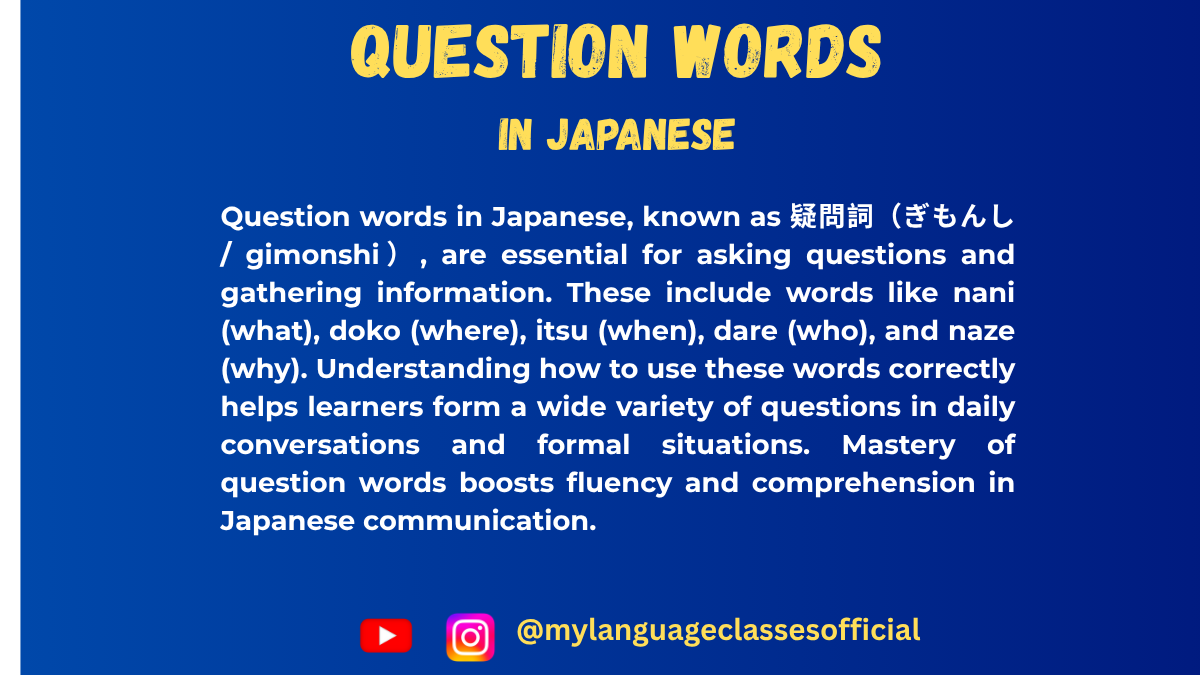
Mastering Question Words in Japanese
Mastering Japanese Question Words
When learning Japanese, understanding how to ask questions is essential to communication. Whether you’re inquiring about someone’s day or seeking directions in Tokyo, mastering question forms will significantly enhance your confidence. In this blog post, we’ll delve into Japanese question words, how to use them, and the role of か (ka) for forming yes/no questions. Let’s get started!
Essential Japanese Question Words
Japanese question words are key for asking specific questions. Here’s a breakdown of the most common ones:
1. 何 (なに/nani) – “What”
- Examples:
- これは何ですか? (Kore wa nani desu ka?) – What is this?
- 何を食べますか? (Nani o tabemasu ka?) – What will you eat?
The word 何 changes depending on context:
- When followed by ですか (desu ka), it remains nani.
- With particles like を (o) or が (ga), it’s also nani.
- Before な (na)-row sounds, it often becomes なん (nan), e.g., 何時 (なんじ/nanji) – “What time?”
2. 誰 (だれ/dare) – “Who”
- Examples:
- 誰ですか? (Dare desu ka?) – Who is it?
- あなたは誰ですか? (Anata wa dare desu ka?) – Who are you?
For polite speech, you can use どなた (donata) instead of 誰.
3. どこ (doko) – “Where”
- Examples:
- トイレはどこですか? (Toire wa doko desu ka?) – Where is the bathroom?
- あなたはどこに住んでいますか? (Anata wa doko ni sunde imasu ka?) – Where do you live?
4. いつ (itsu) – “When”
- Examples:
- いつ来ますか? (Itsu kimasu ka?) – When will you come?
- 試験はいつですか? (Shiken wa itsu desu ka?) – When is the exam?
5. なぜ (naze) / どうして (doushite) – “Why”
- Examples:
- なぜ行きませんか? (Naze ikimasen ka?) – Why won’t you go?
- どうして泣いているんですか? (Doushite naite irun desu ka?) – Why are you crying?
While なぜ and どうして both mean “why,” どうして is more conversational, whereas なぜ is slightly formal.
6. いくら (ikura) – “How much”
- Examples:
- これはいくらですか? (Kore wa ikura desu ka?) – How much is this?
- 昼ご飯はいくらかかりますか? (Hirugohan wa ikura kakarimasu ka?) – How much does lunch cost?
Forming Yes/No Questions with か (ka)
Japanese yes/no questions are incredibly straightforward—just add か to the end of a sentence. Let’s break it down:
1. Verb + か
- Examples:
- 食べますか? (Tabemasu ka?) – Do you eat? / Will you eat?
- 映画を見ますか? (Eiga o mimasu ka?) – Will you watch the movie?
2. Noun + ですか
- Examples:
- 学生ですか? (Gakusei desu ka?) – Are you a student?
- 日本人ですか? (Nihonjin desu ka?) – Are you Japanese?
Adding か turns a statement into a polite question.
Bonus: Combining Question Words with か
You can combine question words with か to create open-ended questions:
- 何か (nani ka) – “Something”
- 誰か (dare ka) – “Someone”
- どこか (doko ka) – “Somewhere”
For example:
- 何か食べますか? (Nani ka tabemasu ka?) – Will you eat something?
- 誰か来ますか? (Dare ka kimasu ka?) – Will someone come?
Pro Tip for Learners
In informal conversation, か is often omitted:
- これ何? (Kore nani?) – What’s this?
- 誰? (Dare?) – Who?
Practice Makes Perfect
To solidify your understanding, try creating sentences using each question word. For instance:
- Where do you live?
- あなたはどこに住んでいますか? (Anata wa doko ni sunde imasu ka?)
- What will you eat?
- 何を食べますか? (Nani o tabemasu ka?)
Post your examples in the comments for feedback or ask additional questions to enhance your learning. Remember, the key to mastering Japanese question forms is consistent practice!
Happy learning! がんばってください! (Ganbatte kudasai!) 😊
If you enjoyed this lesson, be sure to check out more posts like this on my blog at My Language Classes. Don’t forget to subscribe my YouTube channel and follow me on Instagram for the latest language learning tips and lessons. Leave a comment below to share your thoughts, or ask any questions you have about nouns.
📚 Continue Learning Japanese
- Examples:
-
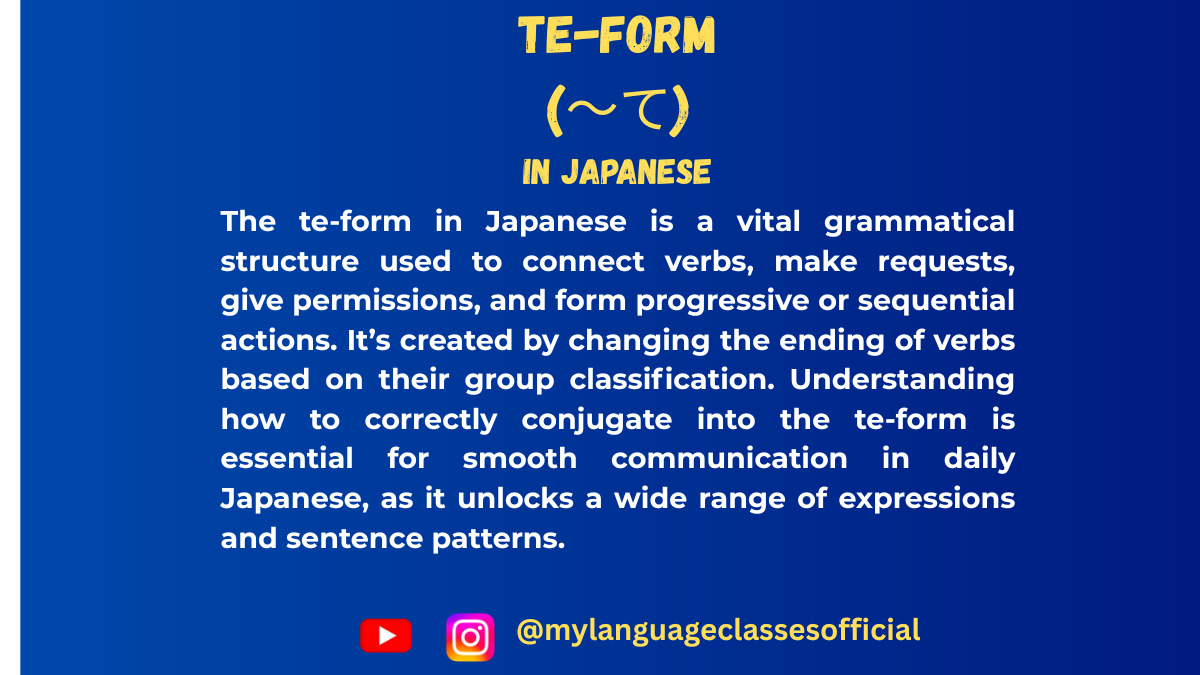
Mastering the Te-Form in Japanese
Mastering the Japanese Te-Form: A Comprehensive Guide
If you’re learning Japanese, one of the most versatile and essential verb forms to master is the te-form. It’s a grammatical powerhouse, allowing you to connect actions, form requests, give commands, and even construct progressive and perfect tenses. Today, let’s dive deep into understanding what the te-form is, why it’s important, and, most importantly, how to form it for all three groups of Japanese verbs.
What Is the Te-Form?
The te-form is a conjugated form of Japanese verbs that ends in て (te) or で (de). It’s named after the final syllable that appears in its conjugation.
Here are the main uses of the te-form:
- Connecting Actions: Link multiple actions in a sentence (e.g., “I woke up, brushed my teeth, and ate breakfast”).
- 朝起きて、歯を磨いて、朝ごはんを食べました。
- Asa okite, ha wo migaite, asagohan wo tabemashita.
- Forming Requests: Politely ask someone to do something.
- ドアを開けてください。
- Doa wo akete kudasai. (Please open the door.)
- Progressive Form: Indicate an ongoing action.
- 今、勉強しています。
- Ima, benkyou shiteimasu. (I’m studying now.)
- Giving Permission or Prohibitions: Say what’s okay or not okay to do.
- 写真を撮ってもいいですか。
- Shashin wo totte mo ii desu ka. (Is it okay to take photos?)
How to Form the Te-Form
To create the te-form, Japanese verbs are categorized into three groups: Group 1 (U-verbs), Group 2 (Ru-verbs), and Group 3 (Irregular verbs). Let’s break down the rules for each group.
Group 1 Verbs (U-Verbs)
Group 1 verbs are the most diverse group. They end in a u sound, such as う, く, す, つ, む, ぶ, ぬ, ぐ, or る (but NOT the same as Group 2 ru-verbs).
Here’s the rule for conjugating these verbs into the te-form:
- Identify the final hiragana of the verb.
- Replace it with its corresponding te/de ending:
Ending in… Change to… Example Te-form う, つ, る って 会う (au, meet) 会って (atte) む, ぶ, ぬ んで 飲む (nomu, drink) 飲んで (nonde) く いて 書く (kaku, write) 書いて (kaite) ぐ いで 泳ぐ (oyogu, swim) 泳いで (oyoide) す して 話す (hanasu, speak) 話して (hanashite)
Group 2 Verbs (Ru-Verbs)
Group 2 verbs are simpler to handle. They end in る, and their stems typically have an i or e vowel sound before る (e.g., 食べる, 見る).
To form the te-form:
- Remove the final る.
- Add て.
Example Verb Te-form 食べる (taberu, eat) 食べて (tabete) 見る (miru, see) 見て (mite)
Group 3 Verbs (Irregular Verbs)
There are only two main irregular verbs, and their te-forms must be memorized.
Verb Te-form する (suru, do) して (shite) 来る (kuru, come) 来て (kite) Another commonly used irregular verb is 行く (iku, go), which is a Group 1 verb but has an exceptional te-form:
- 行く (iku, go) → 行って (itte).
Practice Makes Perfect!
Here’s a quick exercise to check your understanding. Convert the following verbs to their te-forms:
- 飲む (nomu, drink) → __________
- 書く (kaku, write) → __________
- 食べる (taberu, eat) → __________
- 来る (kuru, come) → __________
- 話す (hanasu, speak) → __________
Tips for Remembering the Te-Form
- Group 1 Mnemonic: Think of “tsu, ru, u” as “tte” and “mu, bu, nu” as “nde.” Sing these patterns like a rhythm to memorize them!
- Practice in Context: Use real-life examples to internalize the rules. For example, narrate your daily routine in Japanese using the te-form.
By mastering the te-form, you unlock the ability to express yourself in so many more ways in Japanese. It’s a gateway to conversational fluency and one of the most rewarding aspects of learning the language. So, practice regularly, and soon it’ll feel as natural as saying “ありがとう!”
Got any questions or examples of your own? Share them in the comments!
If you enjoyed this lesson, be sure to check out more posts like this on my blog at My Language Classes. Don’t forget to subscribe my YouTube channel and follow me on Instagram for the latest language learning tips and lessons. Leave a comment below to share your thoughts, or ask any questions you have about nouns.
Happy learning! 😊
📚 Continue Learning Japanese
- Connecting Actions: Link multiple actions in a sentence (e.g., “I woke up, brushed my teeth, and ate breakfast”).

